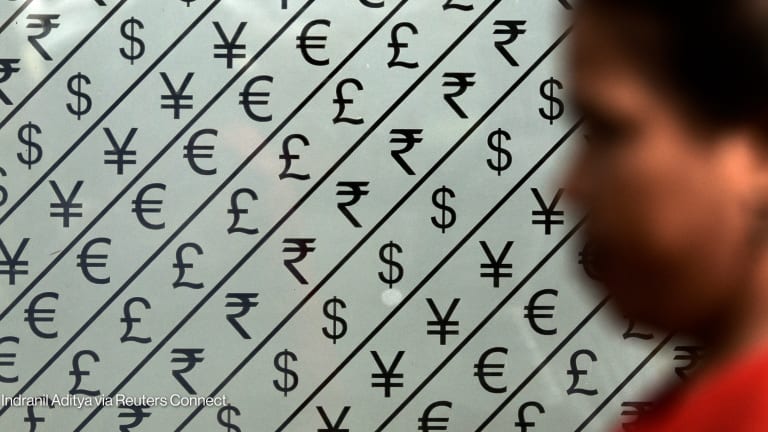USAID business forecast: Q3 2022
The U.S. Agency for International Development is investing up to $31.1 billion in the coming months. Devex looks into the data to know what its priorities are.
On Tuesday, June 7, the U.S. Agency for International Development held its quarterly business forecast conference call. Devex looked into the data to see where the agency is investing its money in the coming months. The business forecast for the third quarter of the year included 257 opportunities, with a total estimated maximum value of up to $31.1 billion — $2.4 billion, or 8.4%, more than the previous quarter. The increase closely relates to a new opportunity in the working in crises and conflict sector: the Support Which Implements Fast Transitions, or SWIFT, 6, which is worth $2.8 billion. SWIFT 6 is USAID’s mechanism that supports local initiatives advancing democracy, peace, and stability. There are no changes recorded around the NextGen contracts. NextGen is USAID’s 10-year global health program that funds the procurement and distribution of health commodities in partner countries, and it still accounts for the biggest portion of USAID's forecasted funding. But as we previously pointed out in the previous forecast, two NextGen Procurement Service Agent, or PSA, contracts remain ambiguous. Both the PSA HIV and Integrated PSA are valued at over $3 billion each, but these contracts were previously listed as having a maximum value of $5 billion and $4.1 billion respectively in the first quarter. All calculations in this analysis use the values in the business forecast. However, there is little to suggest the maximum values of the contracts have changed. Trends in health Global health remains the priority among the sectors, with 44 opportunities worth $16.8 billion. A further $757.4 million is allocated to 15 opportunities for HIV/AIDS, with more than half of the funding coming from the U.S. President's Emergency Plan for AIDS Relief. NextGen contracts accounted for the biggest portion of forecasted funding for health, with $13.6 billion. Aside from the PSA HIV and Integrated PSA, other large contracts include: • Up to $2.8 billion for PSA Diagnostics, which is for the procurement and associated supply chain services for laboratory, diagnostic, and molecular commodities for HIV/AIDS. • Up to $2.5 billion for the Comprehensive Technical Assistance for Health Supply Chain and Pharmaceutical Management, or CompTA. • Up to $1.5 billion for the In-country Logistics, or ICL, which is for the warehousing and transportation of health commodities. Aside from the NextGen, other global health priorities that received signification allocation include: • Up to $1 billion for malaria prevention through vector control. • Up to $300 million for implementation support and technical assistance for malaria control and prevention. • Up to $100 million for the Localize Global Health Security, or LGHS, initiative, which will support local partners to address the gaps in health security. Among country-specific health initiatives, Uganda and Ethiopia remain the priorities. This includes increasing access and improving the health care system in Uganda through a $300 million cooperative agreement, and seven opportunities in Ethiopia, which also has a combined maximum value of around $300 million, ranging from improving health and nutrition, supporting the private health sector, to strengthening public health emergency management. Other development priorities USAID allocated an additional $13.7 billion for 195 opportunities in nine thematic sectors, including: Working in crises and conflict • Up to $2.8 billion for SWIFT 6. • Up to $1.5 billion for administrative, operations, and technical support to the Humanitarian Assistance Support Contract. • Up to $100 million to support a civilian-led democratic transition in Sudan. Environment and global climate change • Up to $1.5 billion for the Energy IDIQ III — USAID’s global contracting mechanism for energy sector programs. It was also the largest forecasted opportunity in this sector in the previous quarter, with similar estimated funding. • Up to $100 million for the New Green Cities mechanism — USAID’s initiative focusing on urban challenges and the climate crisis. • Up to $50 million each for global climate adaptation; sustainable business models for nature tourism and human well-being and biodiversity conservation in Colombia; and conservation and biodiversity and resiliency in Guatemala. One of the biggest environment-related opportunities in the previous business forecast, the Green Recovery Investment Platform, or GRIP, worth $300 million, was delisted from this forecast. The agency has released a solicitation notice related to it, indicating that it has progressed beyond the forecast stage. Democracy, human rights, and governance • Up to $300 million for an annual program statement supporting the El Salvador Country Development Strategy. • Up to $100 million for an anti-corruption program in Ukraine. This increased from a maximum amount of $50 million from the previous forecast. • Up to $100 million to reduce homicides and improve citizen security in El Salvador. Scrutiny and oversight • Up to $610 million for 18 opportunities supporting USAID’s administration and management, both in Washington and missions. This includes analytical and advisory services, human resources support, and monitoring, evaluation, and learning activities. This is down $863.8 million from the previous forecast. Update, June 13, 2022: This article has been updated to reflect the most recent forecast data that was released after USAID’s June 7 conference call. Try out Devex Pro Funding today with a free five-day trial, and explore funding opportunities from over 850 sources in addition to our analysis and news content.
On Tuesday, June 7, the U.S. Agency for International Development held its quarterly business forecast conference call. Devex looked into the data to see where the agency is investing its money in the coming months.
The business forecast for the third quarter of the year included 257 opportunities, with a total estimated maximum value of up to $31.1 billion — $2.4 billion, or 8.4%, more than the previous quarter.
The increase closely relates to a new opportunity in the working in crises and conflict sector: the Support Which Implements Fast Transitions, or SWIFT, 6, which is worth $2.8 billion. SWIFT 6 is USAID’s mechanism that supports local initiatives advancing democracy, peace, and stability.
This story is forDevex Promembers
Unlock this story now with a 15-day free trial of Devex Pro.
With a Devex Pro subscription you'll get access to deeper analysis and exclusive insights from our reporters and analysts.
Start my free trialRequest a group subscription Printing articles to share with others is a breach of our terms and conditions and copyright policy. Please use the sharing options on the left side of the article. Devex Pro members may share up to 10 articles per month using the Pro share tool ( ).
Miguel Tamonan is a Senior Development Analyst at Devex, where he analyzes data from public and private donors to produce content and special reports for Pro and Pro Funding readers. He has a bachelor’s degree in Political Science with a Major in International Relations from the Polytechnic University of the Philippines.








